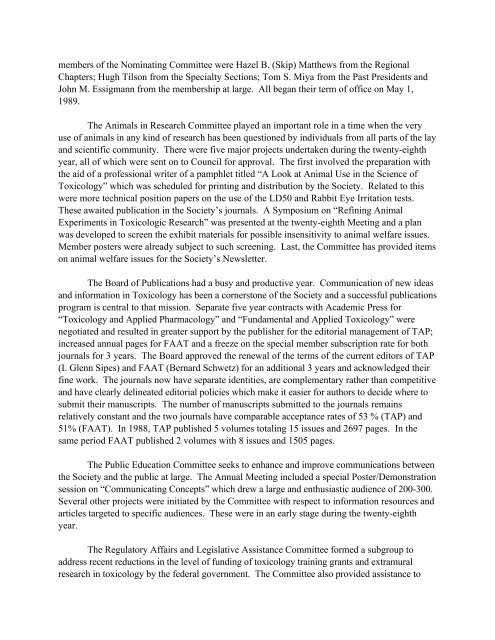SOCIETY O. TOXICOLOGY HISTORY - Society of Toxicology
SOCIETY O. TOXICOLOGY HISTORY - Society of Toxicology
SOCIETY O. TOXICOLOGY HISTORY - Society of Toxicology
Create successful ePaper yourself
Turn your PDF publications into a flip-book with our unique Google optimized e-Paper software.
members <strong>of</strong> the Nominating Committee were Hazel B. (Skip) Matthews from the Regional<br />
Chapters; Hugh Tilson from the Specialty Sections; Tom S. Miya from the Past Presidents and<br />
John M. Essigmann from the membership at large. All began their term <strong>of</strong> <strong>of</strong>fice on May 1,<br />
1989.<br />
The Animals in Research Committee played an important role in a time when the very<br />
use <strong>of</strong> animals in any kind <strong>of</strong> research has been questioned by individuals from all parts <strong>of</strong> the lay<br />
and scientific community. There were five major projects undertaken during the twenty-eighth<br />
year, all <strong>of</strong> which were sent on to Council for approval. The first involved the preparation with<br />
the aid <strong>of</strong> a pr<strong>of</strong>essional writer <strong>of</strong> a pamphlet titled “A Look at Animal Use in the Science <strong>of</strong><br />
<strong>Toxicology</strong>” which was scheduled for printing and distribution by the <strong>Society</strong>. Related to this<br />
were more technical position papers on the use <strong>of</strong> the LD50 and Rabbit Eye Irritation tests.<br />
These awaited publication in the <strong>Society</strong>’s journals. A Symposium on “Refining Animal<br />
Experiments in Toxicologic Research” was presented at the twenty-eighth Meeting and a plan<br />
was developed to screen the exhibit materials for possible insensitivity to animal welfare issues.<br />
Member posters were already subject to such screening. Last, the Committee has provided items<br />
on animal welfare issues for the <strong>Society</strong>’s Newsletter.<br />
The Board <strong>of</strong> Publications had a busy and productive year. Communication <strong>of</strong> new ideas<br />
and information in <strong>Toxicology</strong> has been a cornerstone <strong>of</strong> the <strong>Society</strong> and a successful publications<br />
program is central to that mission. Separate five year contracts with Academic Press for<br />
“<strong>Toxicology</strong> and Applied Pharmacology” and “Fundamental and Applied <strong>Toxicology</strong>” were<br />
negotiated and resulted in greater support by the publisher for the editorial management <strong>of</strong> TAP;<br />
increased annual pages for FAAT and a freeze on the special member subscription rate for both<br />
journals for 3 years. The Board approved the renewal <strong>of</strong> the terms <strong>of</strong> the current editors <strong>of</strong> TAP<br />
(I. Glenn Sipes) and FAAT (Bernard Schwetz) for an additional 3 years and acknowledged their<br />
fine work. The journals now have separate identities, are complementary rather than competitive<br />
and have clearly delineated editorial policies which make it easier for authors to decide where to<br />
submit their manuscripts. The number <strong>of</strong> manuscripts submitted to the journals remains<br />
relatively constant and the two journals have comparable acceptance rates <strong>of</strong> 53 % (TAP) and<br />
51% (FAAT). In 1988, TAP published 5 volumes totaling 15 issues and 2697 pages. In the<br />
same period FAAT published 2 volumes with 8 issues and 1505 pages.<br />
The Public Education Committee seeks to enhance and improve communications between<br />
the <strong>Society</strong> and the public at large. The Annual Meeting included a special Poster/Demonstration<br />
session on “Communicating Concepts” which drew a large and enthusiastic audience <strong>of</strong> 200-300.<br />
Several other projects were initiated by the Committee with respect to information resources and<br />
articles targeted to specific audiences. These were in an early stage during the twenty-eighth<br />
year.<br />
The Regulatory Affairs and Legislative Assistance Committee formed a subgroup to<br />
address recent reductions in the level <strong>of</strong> funding <strong>of</strong> toxicology training grants and extramural<br />
research in toxicology by the federal government. The Committee also provided assistance to
















